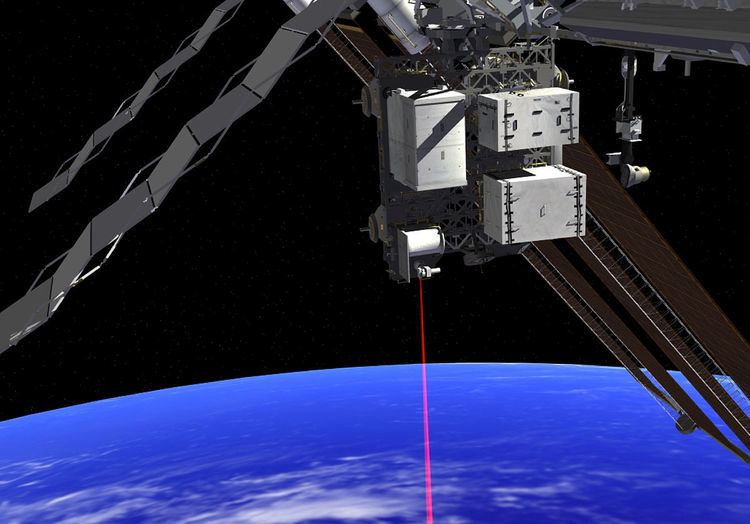 | ||
Laser communication in space refers to the use of laser communications and visible light communication in outer space.
Contents
In outer space, the communication range of free-space optical communication is currently of the order of several thousand kilometers, but has the potential to bridge interplanetary distances of millions of kilometers, using optical telescopes as beam expanders.
Demonstrations
In November 2001 the worlds first laser data connection was achieved in space between the European Space Agency Artemis satellite providing an optical data transmission link with the CNES Earth observation satellite SPOT 4.
In November 2014 the first ever gigabit laser-based communication was achieved by ESA and called the European Data Relay System (EDRS). Now demonstrated the fully completed geostationary EDRS system supporting permanent and high data transfers for low earth orbit weather satellites and many other systems is expected to be in place in the 2016-2017 time frame.
NASA's OPALS announced a breakthrough in space-to-ground laser communication December 9, 2014, uploading 175 megabytes in 3.5 seconds (a speed of 400 megabits a second). The system is also able to re-acquire tracking after the signal is lost due to cloud cover.
In January 2013, NASA used lasers to beam an image of the Mona Lisa to the Lunar Reconnaissance Orbiter roughly 390,000 km (240,000 mi) away. To compensate for atmospheric interference, an error correction code algorithm similar to that used in CDs was implemented.
The distance records for optical communications involved detection and emission of laser light by space probes. A two-way distance record for communication was set by the Mercury laser altimeter instrument aboard the MESSENGER spacecraft. This diode-pumped infrared neodymium laser, designed as a laser altimeter for a Mercury orbit mission, was able to communicate across a distance of 24 million km (15 million miles), as the craft neared Earth on a fly-by in May, 2005. The previous record had been set with a one-way detection of laser light from Earth, by the Galileo probe, as two ground-based lasers were seen from 6 million km by the out-bound probe, in 1992.
Flight tests
In 2008 ESA used laser communication technology designed to transmit 1.8 Gbit/s across 45,000 km, the distance of a LEO-GEO link. Such a terminal was successfully tested during an in-orbit verification using the German radar satellite TerraSAR-X and the American NFIRE satellite. The two Laser Communication Terminals (LCT) used during this tests were built by the German company Tesat-Spacecom in cooperation with the German Aerospace Center (DLR).
A laser communication system was one of four science instruments launched with the NASA Lunar Atmosphere and Dust Environment Explorer (LADEE) mission on 7 Sept 2013. After a month-long transit to the Moon, and a 40-day spacecraft checkout, the laser comm experiments were performed over three months during late 2013 to early 2014. Initial data returned from the Lunar Laser Communication Demonstration (LLCD) equipment on LADEE set a space communication bandwidth record in October 2013 when early tests using a pulsed laser beam to transmit data over the 385,000 kilometres (239,000 mi) between the Moon and Earth passed data at a "record-breaking download rate of 622 megabits per second (Mbps)", and also demonstrated an error-free data upload rate of 20 Mbps from an Earth ground station to LADEE in Lunar orbit. The LLCD is NASA's first attempt at two-way space communication using an optical laser instead of radio waves, and is expected to lead to operational laser systems on NASA satellites in future years.
Laser communication has also been demonstrated on aircraft and high altitude platforms. Applications can be found in the transmission of large data amounts directly from an aircraft (e.g. an Unmanned Aerial Vehicle UAV) to the ground or in the interconnection of stratospheric platforms to build up high-performance backbone networks. A laser link from a jet platform Tornado was successfully demonstrated for the first time in November 2013. A laser terminal of the German company ViaLight Communications was used to transmit data at a rate of 1Gbit/s over a distance of 60 km and at a flight speed of 800 km/h. Additional challenges in this scenario were the fast flight maneuvers, strong vibrations, and the effects of atmospheric turbulence. The demonstration was financed by EADS Cassidian Germany and performed in cooperation with the German Aerospace Center DLR.
Further system and operational service demonstrations were carried out in 2014. Data from the EU Sentinel-1A satellite in LEO was transmitted via an optical link to the ESA-Inmarsat Alphasat in GEO and then relayed to a ground station using a conventional Ka band downlink. The new system can offer speeds up to 7.2 Gbit/s.
Missions
The OPALS experiment was launched on 18 April 2014 to the ISS to further test the potential for using a laser to transmit data to Earth from space.
The technology is a proposed payload for the Phobos And Deimos & Mars Environment (PADME) orbiter.
Engineers of the Asteroid Redirect Mission are contemplating in its early conceptual phase the use of laser communications.
Secure communications
Secure communications have been proposed using a laser N-slit interferometer where the laser signal takes the form of an interferometric pattern. Any attempt to intercept the signal causes the collapse of the interferometric pattern. This technique has been demonstrated to work over propagation distances of practical interest and, in principle, it could be applied over large distances in space. Assuming available laser technology, and considering the divergence of the interferometric signals, the range for satellite-to-satellite communications has been estimated to be approximately 2000 km. These estimates are applicable to an array of satellites orbiting the Earth. For space vehicles or space stations, the range of communications is estimated to increase up to 10000 km. This approach to secure space-to-space communications was selected by Laser Focus World as one of the top photonics developments of 2015.
